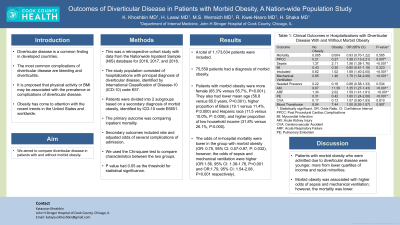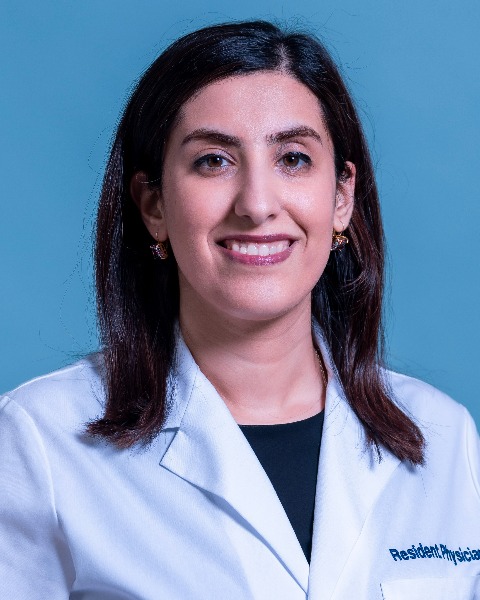Back


Poster Session D - Tuesday Morning
Category: Colon
D0086 - The Outcomes of Diverticular Disease in Patients With Morbid Obesity: A Nationwide Population Study
Tuesday, October 25, 2022
10:00 AM – 12:00 PM ET
Location: Crown Ballroom

Has Audio

Katayoun Khoshbin, MD
John H. Stroger, Jr. Hospital of Cook County
Chicago, IL
Presenting Author(s)
Katayoun Khoshbin, MD1, Hisham Laswi, MD1, Robert Kwei-Nsoro, MD1, Pius E. Ojemolon, MD1, Muhammad Sheharyar Warraich, MD, MBBS2, Hafeez Shaka, MBBS1
1John H. Stroger, Jr. Hospital of Cook County, Chicago, IL; 2John H. Stroger Jr. Hospital of Cook County, Chicago, IL
Introduction: Diverticular disease is a common finding in developed countries. The most common complications of diverticular disease are bleeding and diverticulitis, these may prompt hospitalization and therefore, increase the healthcare burden. It is proposed that physical activity or BMI may be associated with the prevalence or complications of diverticular disease. Obesity has come to attention with the recent trends in the United States and worldwide. In this study, we aimed to compare diverticular disease in patients with and without morbid obesity.
Methods: This was a retrospective cohort study with data from the Nationwide Inpatient Sample (NIS) database for 2016, 2017, 2018, and 2019. The study population consisted of hospitalizations with a principal diagnosis of diverticular disease, identified by the International Classification of Disease-10 (ICD-10) code K57. Patients were divided into 2 subgroups based on a secondary diagnosis of morbid obesity, identified by ICD-10 code E6601. The primary outcome was comparing inpatient mortality. Secondary outcomes included the rate and adjusted odds of several complications of admission. We used the Chi-square test to compare characteristics between the two groups and logistic regression to compare the complications of admissions. P-value had 0.05 as the threshold for statistical significance.
Results: A total of 1,173,634 patients were included, and 75,559 had a diagnosis of morbid obesity. Patients with morbid obesity were more female (65.3% versus 55.7%, P< 0.001). They also had lower mean age (56.8 versus 65.0 years, P< 0.001), higher proportion of Black (19.1 versus 11.4%, P:0.000) and Hispanic race (11.5 versus 10.0%, P: 0.000), and higher proportion of low household income (31.8% versus 26.1%, P:0.000). The odds of in-hospital mortality were lower in the group with morbid obesity (OR: 0.75, 95%CI: 0.57-0.97, P: 0.032), however, the odds of sepsis and mechanical ventilation were higher (OR:1.56, 95% CI: 1.38-1.76, P< 0.001 and OR:1.79, 95%CI: 1.54-2.08, P< 0.001 respectively).
Discussion: Patients with morbid obesity who were admitted due to diverticular disease were younger, from lower quartiles of income and more from racial minorities. Morbid obesity was associated with higher odds of sepsis and mechanical ventilation; however, the mortality was lower. This may be explained by the younger age of the group.
Disclosures:
Katayoun Khoshbin, MD1, Hisham Laswi, MD1, Robert Kwei-Nsoro, MD1, Pius E. Ojemolon, MD1, Muhammad Sheharyar Warraich, MD, MBBS2, Hafeez Shaka, MBBS1. D0086 - The Outcomes of Diverticular Disease in Patients With Morbid Obesity: A Nationwide Population Study, ACG 2022 Annual Scientific Meeting Abstracts. Charlotte, NC: American College of Gastroenterology.
1John H. Stroger, Jr. Hospital of Cook County, Chicago, IL; 2John H. Stroger Jr. Hospital of Cook County, Chicago, IL
Introduction: Diverticular disease is a common finding in developed countries. The most common complications of diverticular disease are bleeding and diverticulitis, these may prompt hospitalization and therefore, increase the healthcare burden. It is proposed that physical activity or BMI may be associated with the prevalence or complications of diverticular disease. Obesity has come to attention with the recent trends in the United States and worldwide. In this study, we aimed to compare diverticular disease in patients with and without morbid obesity.
Methods: This was a retrospective cohort study with data from the Nationwide Inpatient Sample (NIS) database for 2016, 2017, 2018, and 2019. The study population consisted of hospitalizations with a principal diagnosis of diverticular disease, identified by the International Classification of Disease-10 (ICD-10) code K57. Patients were divided into 2 subgroups based on a secondary diagnosis of morbid obesity, identified by ICD-10 code E6601. The primary outcome was comparing inpatient mortality. Secondary outcomes included the rate and adjusted odds of several complications of admission. We used the Chi-square test to compare characteristics between the two groups and logistic regression to compare the complications of admissions. P-value had 0.05 as the threshold for statistical significance.
Results: A total of 1,173,634 patients were included, and 75,559 had a diagnosis of morbid obesity. Patients with morbid obesity were more female (65.3% versus 55.7%, P< 0.001). They also had lower mean age (56.8 versus 65.0 years, P< 0.001), higher proportion of Black (19.1 versus 11.4%, P:0.000) and Hispanic race (11.5 versus 10.0%, P: 0.000), and higher proportion of low household income (31.8% versus 26.1%, P:0.000). The odds of in-hospital mortality were lower in the group with morbid obesity (OR: 0.75, 95%CI: 0.57-0.97, P: 0.032), however, the odds of sepsis and mechanical ventilation were higher (OR:1.56, 95% CI: 1.38-1.76, P< 0.001 and OR:1.79, 95%CI: 1.54-2.08, P< 0.001 respectively).
Discussion: Patients with morbid obesity who were admitted due to diverticular disease were younger, from lower quartiles of income and more from racial minorities. Morbid obesity was associated with higher odds of sepsis and mechanical ventilation; however, the mortality was lower. This may be explained by the younger age of the group.
Disclosures:
Katayoun Khoshbin indicated no relevant financial relationships.
Hisham Laswi indicated no relevant financial relationships.
Robert Kwei-Nsoro indicated no relevant financial relationships.
Pius Ojemolon indicated no relevant financial relationships.
Muhammad Sheharyar Warraich indicated no relevant financial relationships.
Hafeez Shaka indicated no relevant financial relationships.
Katayoun Khoshbin, MD1, Hisham Laswi, MD1, Robert Kwei-Nsoro, MD1, Pius E. Ojemolon, MD1, Muhammad Sheharyar Warraich, MD, MBBS2, Hafeez Shaka, MBBS1. D0086 - The Outcomes of Diverticular Disease in Patients With Morbid Obesity: A Nationwide Population Study, ACG 2022 Annual Scientific Meeting Abstracts. Charlotte, NC: American College of Gastroenterology.
